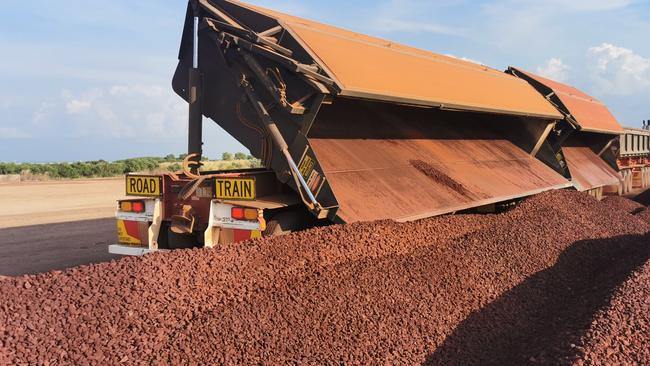Iron ore prices back on the radar amid waning optimism on China
Iron ore prices have tumbled amid growing doubts about steel demand for China’s flagging property sector. So will prices go above $US110 a tonne again this year?

Business
Don't miss out on the headlines from Business. Followed categories will be added to My News.
Tumbling iron ore prices have been a headwind for the Australian share market this week as confidence in China’s latest attempts to stimulate its flagging property sector starts to wane.
While the US share market continued to hit record highs before crucial updates on US inflation and monetary policy, Australia’s S&P/ASX 200 index retreated for a second day running.
After surging toward record highs at the start of the month, the S&P/ASX 200 fell as much as 2 per cent at the start of the week, a move that coincided with iron ore futures hitting a two-month low of $US103.35 a tonne and a downturn in Australia’s biggest mining companies.
Adding to the pullback in the ASX 200 was a jump in bond yields after strong US employment data fuelled worries that interest rates could stay high for longer than previously expected and also contributed to a rise in the US dollar which weighed on commodity prices.

Analysts said a sharp fall in iron ore prices below $US105 a tonne was linked to waning optimism about the efficacy of the property stimulus measures announced by China last month.
“The fall in iron ore prices likely reflects growing worries that China’s property sector will continue to remain a headwind despite attempts by policymakers to rescue the property sector,” said Vivek Dhar, head of mining and energy commodity research at CBA.
Iron ore prices defied the odds last year, rising as much as 69 per cent from lows around $US80 a tonne to highs around $US134 a tonne by early January.
Investors hoped the piecemeal stimulus measures announced by China would be enough to arrest a deflationary spiral led by a lack of confidence in its residential property market after the collapse of some large developers.
But over the next three months the price of Australia’s most valuable export slumped 30 per cent to $US94.50 a tonne, a level where analysts said marginal producers would be uneconomic.
A 30 per cent rebound to $US123 over the next two months was aided by the latest property stimulus plans unveiled by China on May 17.
Those measures included typical demand-side adjustments to encourage buyers, such as removing the mortgage floor for first and second home purchases at the national level and reducing the minimum down payments ratios for first and second home buyers to record lows
CBA’s Dhar said the measure that garnered the most hope was a plan to support local governments to acquire unsold properties and convert them into affordable public housing.
China’s central government was willing to lend RMB300 billion ($63bn), with hopes that it would be enough to generate total funding of RMB500 billion.
Chinese commercial banks were expected to step in with additional loans.
The main criticism of this policy measures centres on whether the amount the government was willing to commit will be enough to meaningfully reduce the excess inventory in housing inventory. Market estimates of the value of excess housing stock in China ranged from RMB2.5 trillion to RMB7 trillion – vastly more than the government was willing to commit.
Mr Dhar warned that existing lending programs relying on China’s commercial banks for additional funding have shown very little take up by those banks, probably due to concern over the potential default risks for property developers.
And the plan to rely on local governments to reduce excess housing inventory may also be met by limited interest given local government concerns over worsening their existing debt problems.
“All in all, it’s not too surprising to see iron ore prices return back to $US100-110 per tonne,” Mr Dhar said. “We think this price range is broadly consistent with China’s steel demand and output tracking sideways this year.”
But less demand from China’s property sector may be offset by gains in China’s infrastructure-related steel demand. Each sector accounts for about 30 per cent of China’s steel consumption.
“Combining the sources of potential infrastructure spending suggests fairly flat infrastructure investment growth in 2024,” he added.
“However, given that half of the sovereign bonds issued late last year will be used in 2024, the potential increase in infrastructure spending this year is likely equivalent to 0.5-1 per cent of GDP.”
His view now is that additional infrastructure stimulus plans will be needed to push iron ore prices sustainably above $US110 a tonne but that will be on the cards later this year if China looks set to undershoot its 5 per cent economic growth target in 2024.
At the same time, he doubts iron ore prices will go much lower than $US100 a tonne in a sustained way as seaborne supplies will “likely exit the market below these levels”.
“We believe seaborne supply needs to remain stable to support our view that China’s steel demand and output will remain fairly flat this year,” Dhar said.
Originally published as Iron ore prices back on the radar amid waning optimism on China



